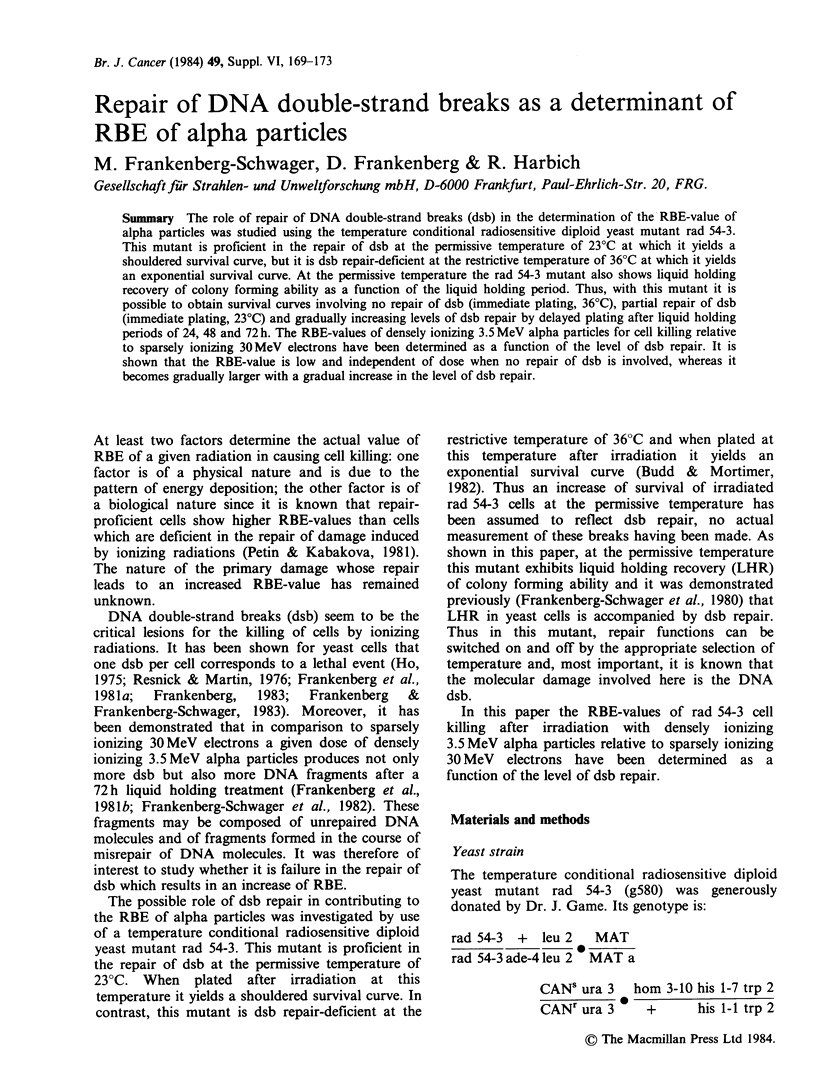Abstract
The role of repair of DNA double-strand breaks (dsb) in the determination of the RBE-value of alpha particles was studied using the temperature conditional radiosensitive diploid yeast mutant rad 54-3. This mutant is proficient in the repair of dsb at the permissive temperature of 23 degrees C at which it yields a shouldered survival curve, but it is dsb repair-deficient at the restrictive temperature of 36 degrees C at which it yields an exponential survival curve. At the permissive temperature the rad 54-3 mutant also shows liquid holding recovery of colony forming ability as a function of the liquid holding period. Thus, with this mutant it is possible to obtain survival curves involving no repair of dsb (immediate plating, 36 degrees C), partial repair of dsb (immediate plating, 23 degrees C) and gradually increasing levels of dsb repair by delayed plating after liquid holding periods of 24, 48 and 72 h. The RBE-values of densely ionizing 3.5 MeV alpha particles for cell killing relative to sparsely ionizing 30 MeV electrons have been determined as a function of the level of dsb repair. It is shown that the RBE-value is low and independent of dose when no repair of dsb is involved, whereas it becomes gradually larger with a gradual increase in the level of dsb repair.
Full text
PDF




Selected References
These references are in PubMed. This may not be the complete list of references from this article.
- Budd M., Mortimer R. K. Repair of double-strand breaks in a temperature conditional radiation-sensitive mutant of Saccharomyces cerevisiae. Mutat Res. 1982 Jan;103(1):19–24. doi: 10.1016/0165-7992(82)90080-x. [DOI] [PubMed] [Google Scholar]
- Frankenberg-Schwager M., Frankenberg D., Blöcher D., Adamczyk C. Repair of DNA double-strand breaks in irradiated yeast cells under nongrowth conditions. Radiat Res. 1980 Jun;82(3):498–510. [PubMed] [Google Scholar]
- Frankenberg-Schwager M., Frankenberg D., Blöcher D., Adamczyk C. The influence of oxygen on the survival and yield of DNA double-strand breaks in irradiated yeast cells. Int J Radiat Biol Relat Stud Phys Chem Med. 1979 Sep;36(3):261–270. doi: 10.1080/09553007914551031. [DOI] [PubMed] [Google Scholar]
- Frankenberg D., Frankenberg-Schwager M., Blöcher D., Harbich R. Evidence for DNA double-strand breaks as the critical lesions in yeast cells irradiated with sparsely or densely ionizing radiation under oxic or anoxic conditions. Radiat Res. 1981 Dec;88(3):524–532. [PubMed] [Google Scholar]
- Frankenberg D., Frankenberg-Schwager M. Interpretation of the shoulder of dose-response curves with immediate plating in terms of repair of potentially lethal lesions during a restricted time period. Int J Radiat Biol Relat Stud Phys Chem Med. 1981 Jun;39(6):617–631. doi: 10.1080/09553008114550741. [DOI] [PubMed] [Google Scholar]
- Ho K. S. Induction of DNA double-strand breaks by X-rays in a radiosensitive strain of the yeast Saccharomyces cerevisiae. Mutat Res. 1975 Dec;30(3):327–334. [PubMed] [Google Scholar]
- Petin V. G., Kabakova N. M. Rbe of densely ionizing radiation for wild-type and radiosensitive mutants of yeast. Mutat Res. 1981 Jul;82(2):285–294. doi: 10.1016/0027-5107(81)90158-5. [DOI] [PubMed] [Google Scholar]
- Resnick M. A., Martin P. The repair of double-strand breaks in the nuclear DNA of Saccharomyces cerevisiae and its genetic control. Mol Gen Genet. 1976 Jan 16;143(2):119–129. doi: 10.1007/BF00266917. [DOI] [PubMed] [Google Scholar]


